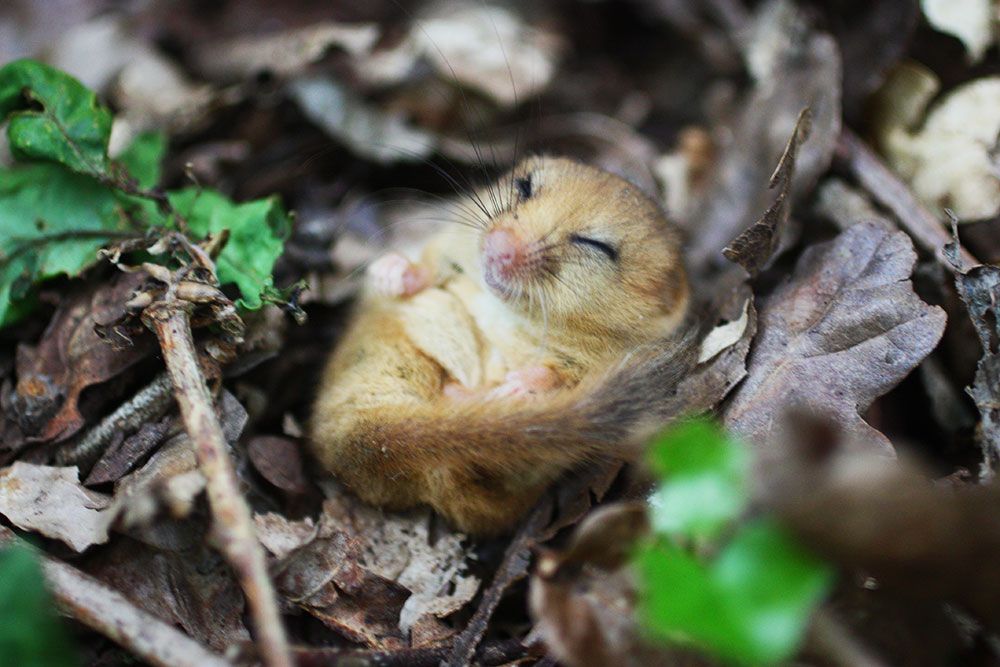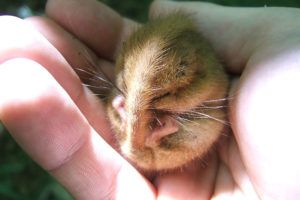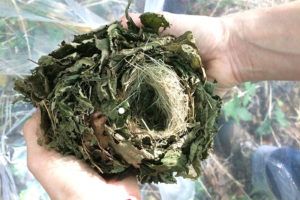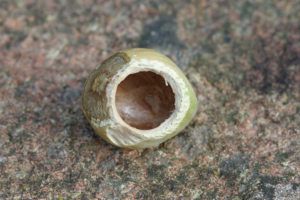Hazel dormouse ecology

The head and body of a hazel dormice is about 8cm long, with a tail length of about 6.5cm, They have relatively large eyes and small, round ears. Their weight varies through the year but it averages 19-20g. When they start to put on weight prior to going into hibernation they can weigh between 30g-40g. Their average lifespan is three years in the wild but they can live up to five years. They’re the only small mammal in the UK with a furry tail.
Species: Hazel Dormouse Muscardinus avellanarius
Class: Mammalia (Mammals)
Order: Rodentia (Rodents)
Suborder: Sciuriomorpha (Squirrel-like rodents)
Family: Gliridae (Dormice)
Genus: Muscardinus
A year in the life of a dormouse
In the UK hazel dormice spend the winter in hibernation and will start to emerge during March. The males will generally awaken about two weeks before females. By April about half the population is active. Dormice are strongly nocturnal and only occasionally active during afternoon hours. Torpid dormice (with reduced metabolic rate and temperature) are found in spring and in May over 50% of dormice found in nest boxes are torpid.
Occasionally they may breed in May or June but this is unusual – our monitoring data suggests that just 0.69% of litters are recorded in May and 5.11% in June. Most litters are recorded in August (31.0%) or September (35.8%). By late September dormice can start to increase their weight for hibernation and this can continue into October and November.
Hibernation

Dormice hibernate to outlast a lack of food over winter. It’s a special state that the body undergoes when all vital functions are reduced to a minimum. Their hibernation is interrupted with periodic arousals (with a high energy cost), possibly to expel metabolic waste products. They hibernate on the ground where temperatures are more stable and conditions damper to avoid desiccation. They make small nests that they seal themselves into under log piles, the base of tree stumps, in soil depressions or under leaf litter. Dormice will lose about 30% of body weight during hibernation and so to survive, it is thought they need to weigh at least 15-18g in the autumn.
Breeding
Pregnancy lasts for about 3.5 weeks with an average litter size of four typically born in late July, August or early September. Occasionally litters can be recorded in late May or early June. Young are weaned after four weeks but may remain with the mother as juveniles for a further four weeks before they become independent and disperse. A single litter is usual, but early breeding females may have a second litter. The young are sexually mature after 8-10 weeks, so it is possible that young from early litters could breed in the same year.
Nests

Dormice construct different types of summer nests which are well insulated so that they can save energy to maintain their body temperature:
- Mixed nests of equal volumes of leavers and grass
- Grassy nests often found in conifer
- Foliage nests made from dry or fresh leaves
- Layered nests with and outer layer of leaves and an inner woven nest, used only by females for breeding
Honeysuckle is often an important component of nests. While the presence of green leaves doesn’t always signify dormouse presence, if those leaves were cut from a tree and carried to the nest from afar, it’s highly likely to be a dormouse nest.
Feeding

Dormice lack a caecum in their gut so they aren’t well-adapted to digest cellulose in leaves. They are known as successional feeders as they feed on a range of foods as they come available.
In spring, for example, they will feed on willow catkins, flowers of oak, hawthorn, sycamore and willow. As these foods become unavailable they will move to later flowering plants such as honeysuckle and bramble, and invertebrates like caterpillars, aphids and wasp galls. Bramble is a very valuable plant to dormice as it has both a long flowering and fruiting season. In high summer, when few flowers are available and the shrubs have not yet produced berries or nuts, dormice will move higher into the woodland canopy and eat a variety of invertebrates. In autumn, they will eat fruits and berries such as blackberries and hazelnuts to fatten for hibernation.
Population density
Due to their specialised habitat requirements and their low breeding potential, dormice densities are lower than other rodents with an average of 4–10 animals in spring per hectare in ideal habitat. This drops to about two dormice per hectare in spring in oak dominated wood with hazel.
Home ranges
Dormice are relatively sedentary mammals. Male home ranges are larger than females, the range of one male usually partially overlapping the ranges of several females. Radio tracking studies suggest that a male home range is about 0.5 hectare and a female about 0.2 hectare.
We have been working to save hazel dormice in the UK for over 20 years. Find out about our campaigns and how you can help.
Go back to About hazel dormice
